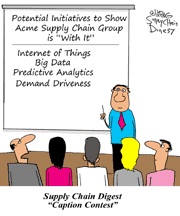 |
August 15, 2014 - Supply Chain Flagship Newsletter |
 |
| SPONSOR: LOGILITY |
||
 |
||
Do You Need Better Visibility Into Your Supply Chain? |
||
| Download the Complimentary White Paper to Learn How |
||
 |
|
||||||||||||||||||||||||||||||||||||||||||||||||||||||||||||||||||||||||||||
Getting Planning in the Supply Chain Right Part 2
|
|||||||||||||||||||||||||||||||||||||||||||||||||||||||||||||||||||||||||||||
| GILMORE SAYS: |
"Murphy is not only walking our projects. He walks our offices, factories or warehouses. Murphy is in our employee's homes, our suppliers operations, our logistics partner's trucks, ships and aircraft." WHAT DO YOU SAY? |
Last week, I said that there is a problem with planning in the supply chain at many companies. By that, I do not mean "planning" in the sense of supply chain planning software, such as determining how much inventory I need next month.
Instead I am referring to the general planning process in day to day business operations. Most companies insufficiently considered risk, and develop plans that are not flexible enough in the face of the inevitable deviations from the assumptions upon which the plan rests (stated or unstated).
What Will Keep Our Plan from Succeeding?
When I see a plan that is nothing more than a sequential list of tasks, I know the people who created the plan made no effort to consider the risks. When I see conditional statements in the plan (if this happens, then do this) I know the planners thought about some of what could go wrong. Conditional steps in a plan indicate that the leaders are thinking of the risks.
Throughout the planning process, leaders have to dive deep and identify the strategic risks to the plan. What kinds of strategic risks you need to worry about depends on the scope and scale of the plan. Strategic trends help to define strategic risks, and tactical trends the tactical risks. Strategic trends happen outside of the business while tactical trends happen both inside and outside of the business.
A business can control the tactical trends by working on developing the tactics used in execution and then execution performance. However, even the strongest of businesses has little influence on the strategic trends. Strategic trends are the external forces that present opportunity and peril to the enterprise. The leaders must understand which strategic trends affect the business and the plans for the business.
What kinds of influencing trends should a leader consider? Moreover, where can a leader turn to figure out what the influencing trends are?
Using Scenarios
Perhaps the gold standard for global planning is the work that Shell Oil does developing scenarios. In the early 1970s, the senior executives at Shell asked the planning group to identify what business conditions the company should plan for. These planners, led by Pierre Wack, developed two competing scenarios that predicted the oil shock that followed two years later in 1973.
 In one scenario, Wack's team predicted an armed conflict in the Middle East, potentially involving Israel, various Arab states, and the associated allies, triggering an economic response by the major oil producing Arab states.
In one scenario, Wack's team predicted an armed conflict in the Middle East, potentially involving Israel, various Arab states, and the associated allies, triggering an economic response by the major oil producing Arab states.
Such events did happen. Egypt and Syria invaded parts of Israel, starting the Yom Kippur War of 1973. That war and the resulting energy crisis caught the oil producers flatfooted - except for Shell. As the events unfolded, Shell shifted supply points, making trades on commodity exchanges and committing to crude supplies ahead of the change in the market.
Shell's leadership was not caught surprised with the rapidly changing geo-political environment because it imagined what could happen - a profited significantly as a result.
Few other companies create planning scenarios to the depth of the Shell teams. Nor do they take the "long view" the way Shell does. The few examples of companies investing in the long view, dedicating capital, time and money to research and develop an understanding of the future, also include Google, General Electric, Siemens, Honda, DHL,and IBM, each of which invests in research and development that may not have a measurable return in what investment markets consider long term, five years, but which could shape how those companies shape the next decades.
How are We Going to Ensure We Make it?
Moving past the strategic questions, planning includes knowing what tactics we should deploy, and what tactics we can deploy. If strategy provides the why behind our planning, tactics are the what we do in our planning.
In any operation, we are in full control of our tactical options. Again, our defined outcome helps shape the tactics we choose in our planning. However, our tactical capabilities shape our planning. Do we know how to perform the job? What do we need to do to get the skills, knowledge, or tools that we must have to do the job? Asking these questions are all critical to the planning process.
Expect the Unexpected
As I noted above, many planning assumptions inevitably turn out to be wrong.
"Mr. Murphy maintains a shack on site. Our job is to try to keep him in his shack. But when he does walk the site, you better be ready with Plan B."
This is a line that I use whenever I am staring a project, and often in the project. When I serve as a program manager, I send every project manager in the program a poster about Mr. Murphy.
You can't stop Murphy, but you can plan for what he does. No matter the scope or scale of the project, I look hard to identify all the places where Murphy can create havoc, determine the damage that could happen, what I can do to prevent it, and what to do if we can't stop him. The larger the project, the broader the scope, the more likely multiple things can and will go wrong.
Murphy is not only walking our projects. He walks our offices, factories or warehouses. Murphy is in our employee's homes, our suppliers operations, our logistics partner's trucks, ships and aircraft. Going after Murphy is just the first step - the tactical step. Murphy appears in the little things, late deliveries, miss-measured lines, labor not showing up, or a bad batch of materials.
Are you Planning?
Organization leaders want to think that they are planning their futures. Those same leaders believe that their teams plan their work. And while everybody thinks they are planning their work, in most cases they engage in list making, not planning. Lists are a small and necessary part of the planning process, but lists are not planning.
As a leader, (and we all are leaders in some form), are you actually planning, or just making a list? Are you defining the desired outcome, or depending on assumed jargon? Are you thinking of how your plans fit into the greater future picture, or just focused on the next few hours?
Do you agree many companies do not do planning effectively? Why or why not? Do too few companies really plan for the unexpected? Let us know your thoughts at the Feedback section below.
![]()
| View Web/Printable Version of this Column |
|
|
|
YOUR FEEDBACK
We received a few nice letters on our recent First Thoughts piece on Insights from Unilever's Perfect Logistics Network Exercise, but frankly not as many as we expected given how innovative this program was. Please send in your thoughts on our articles.
Below you will find our feedback of the week on this topic, from David Armstrong of Inventory Curve, as well as a few others.
Feedback on the Week on Unilever Perfect Logistics Network:
1) Reaction to Unilever's perfect network exercise Based on the article, Unilever US has done an excellent job narrowing down and defining opportunities. While it tends to support the 80/20 factoid that you started with, it is important to recognize the opportunities are both short term and long term. Locking in a network tends to lock in things as they are at the time, but the environment is dynamic. Things are always changing, so it is entirely possible the network decisions made in the past were the right ones to do at that time and now they don't match the current environment.
So there really are two opportunities to work on moving forward: operational and network design. And it does not surprise me at all that when Unilever applies this approach in other geographies, that they find significant differences. 2) Unilever's recent corporate performance I looked at Unilever's corporate financials, not just in the US, and found some nice improvements over the past three years. Gross margin is up to 41.3% from 39.9% and distribution costs as a percentage of Sales and Administrative expenses have declined from 25.4% to 24.0%. Inventory turnover increased from 6.3 to 7.0. As a result, GMROI (Gross Margin Return on Inventory Investment) improved from 4.18 to 4.93. And they have a current cash to cash cycle of negative 59.7 days. David Armstrong
|
||
| More on Unilever Network: | ||
This is really quite innovative, and something I am surprised either hadn't been invented before, or of it has, become more broadly understood used. Being in the CPG industry ourselves, you can trust your column generated quite a bit of discussion around the proverbial watercooler the next day - we are already looking at how we might begin such a program. Keep up the good work!
Director of Logistics Name witheld by request |
||
Love the article on Unilever's pursuit of the perfect network! We are embarking on a very similar quest, and using Llamasoft as our network design tool. Would love to chat about this quest, plus see if you think it would be worth a chat with Unilever to get some "lessons learned."
VP of Transportation Name witheld by request Editor's Note: As is almost always the case, SCDigest editor Dan Gilmore is pleased to help in this case.
|
||
This is really good idea - wish I would have thought of it first. The key of course is how you can really breakdown or segment as you said the different cost buckets after you determine the perfect logistics network costs - the latter would seen to me the easy part if you had a good tool. But identifying and segmenting the other costs to reach the 100% of actual spend - that seems really difficult,. Would love to understand more how that was done. Can SCDigest do some follow up? You also do a masterful job taking a complex topic and making it understandable for readers- keep up the great work! Todd Bunning Carlsbad, CA
|
SUPPLY CHAIN TRIVIA ANSWER
Q: Rank these five sectors according Days Inventory Outstanding, from lowest (best) to highest in 2013, according to SCDigest's recent analysis of the annual REL data:
Consumer packaged goods, retail grocery, food manufacturing, computers and peripherals, and office furniture.
A: Office furniture (16.3 days), retail grocery (21.7), computers and peripherals (25.6), consumer packaged goods (33.8), and food manufacturing (43.1).
| © SupplyChainDigest™ 2003-2014. All Rights Reserved. SupplyChainDigest PO Box 714 Springboro, Ohio 45066 |
POWERED BY: XDIMENSION
|








